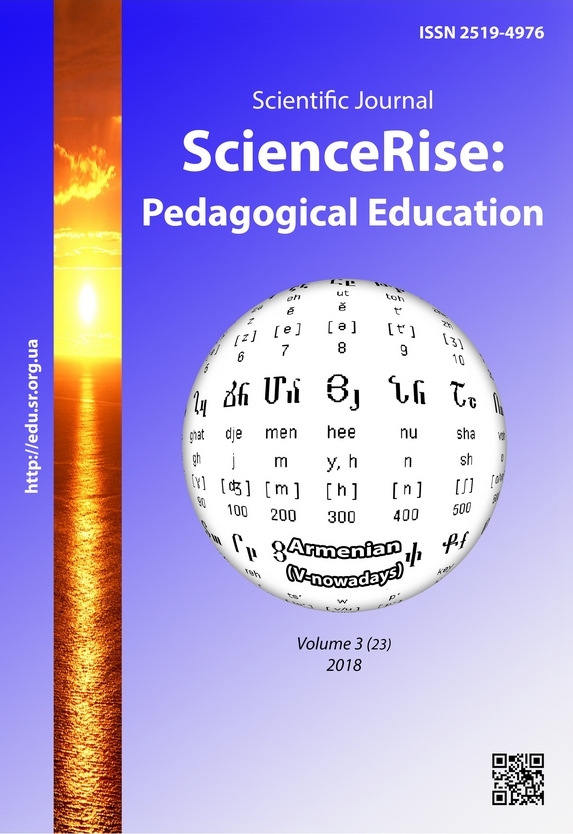The basic principles and content of the technology of forming the readiness of future teachers of musical art for professional activities in creative artistic groups
DOI:
https://doi.org/10.15587/2519-4984.2018.127309Keywords:
formation, readiness, teachers, future teachers, music, art, musical art, professional activityAbstract
The article reveals the basic principles of formation of professional activity of future teachers in creative artistic groups. The content of the technology of forming the readiness of future teachers is determined. The leading directions of competence and creative development, principles of forming the readiness of a future teacher of music are highlighted. The scientific and pedagogical principles of formation of professional competences of future music teachers in the process of professional training are also covered.
The necessity of using the musical-didactic principles in the educational process aimed at developing the artistic competence of future music teachers and music managers is argued; the content of these principles is revealed.
The system of professional training of future music teachers as the final result of this process considers the professional competence as an important new formation of the personality, integrating various qualities and properties of a person. The professional competence of a music teacher is a characteristic of a teacher, in which the leading quality is the practical readiness to implement professional musical and pedagogical activity based on the integration of pedagogical and special abilities, acquired knowledge, and formed skills. In modern conditions, the lack of spirituality was particularly acute in the problem of improving the work of pedagogical universities in raising the level of teacher training. Their professional activity requires rapid orientation in the new social environment, the development of creative abilities, subtle sensitivity, tolerance, readiness for future teacher work. The musical and aesthetic activity of a teacher includes great opportunities for revealing his creative potential, enriches the aesthetic experience, develops emotional and sensual expression, activates the formation of performing skills. All this requires from a future specialist not only the mastering of theoretical knowledge, practical skills, but also the ability to implement them in specific pedagogical situations.
In today's conditions of integration of Ukraine into the world and European cultural space a significant role belongs to education, which is intended to orient young people on their comprehensive self-development and creative self-realization
References
- Rostovsky, O. Ya. (2000). Music education in Ukraine at the turn of the millennium: state, problems, perspectives Arts and education, 4 (18), 9–13.
- Rudnitskaya, O. P. (2002). Pedagogy: general and artistic: Teaching. manual. Kyiv, 270.
- Bondar, V. (2008). Competitiveness of the teacher as a component of his professional competence. Primary school, 7, 22–23.
- Padalka, H. M. (1982). Teacher, music, children. Kyiv: Musical Ukraine, 144.
- Barenboim, L. A. (1973). The path to music. Leningrad: Sovetskiy kompozitor, 270.
- Tsypin, G. M. (1975). Development of a student-musician in the process of learning the game on the piano. Moscow: MGPI, 106.
- Shchapov, A. P. (2000). Piano Pedagogy. Moscow: Sovetskaya Rossiya, 180.
- Mutsmacher, V. I. (1989). About the development of professionally significant cinema teacher-musician. Music in school, 4, 24–27.
- Tsypin, G. M. (1984). Learning the Piano Game. Moscow: Enlightenment, 176.
- Shatskaya, V. I. (1975). Musical-aesthetic education of children and youth. Moscow: Education, 200.
- Dokshitser, T. (1999). The Way to Creativity. Moscow: Murave, 216.
- Dokshitser, T. (2008). Trubach on the horse. Moscow: Composer, 232.
- Zavalko, K. (2013). Utilizing the Dalcroze method to improve teaching children to play violin. Dalcroze Studies. Coventry, 56.
- Zavalko, K. (2011). Improvisation as a form of primary musical and creative activity of the child. European Network of Music Educators and Researchers of Young Children. Helsinki, 375–383.
Downloads
Published
How to Cite
Issue
Section
License
Copyright (c) 2018 Svetlana Chirkina

This work is licensed under a Creative Commons Attribution 4.0 International License.
Our journal abides by the Creative Commons CC BY copyright rights and permissions for open access journals.
Authors, who are published in this journal, agree to the following conditions:
1. The authors reserve the right to authorship of the work and pass the first publication right of this work to the journal under the terms of a Creative Commons CC BY, which allows others to freely distribute the published research with the obligatory reference to the authors of the original work and the first publication of the work in this journal.
2. The authors have the right to conclude separate supplement agreements that relate to non-exclusive work distribution in the form in which it has been published by the journal (for example, to upload the work to the online storage of the journal or publish it as part of a monograph), provided that the reference to the first publication of the work in this journal is included.








